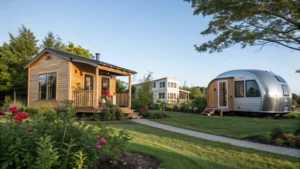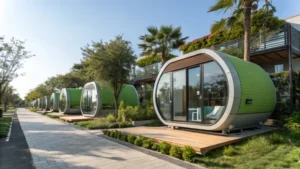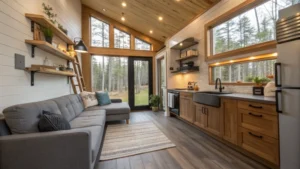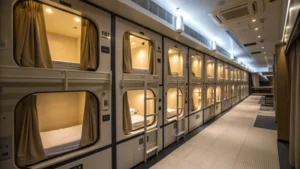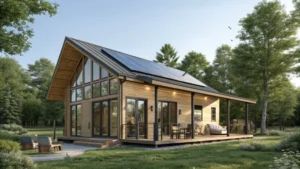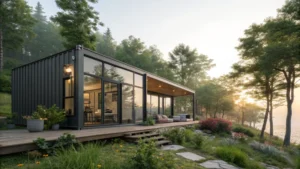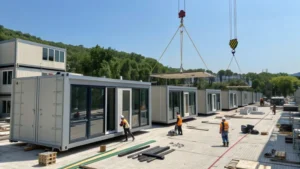
I once found myself enchanted by the idea of tiny living, and I couldn't help but wonder if Amazon's tiny homes were the real deal or just a clever marketing gimmick.
Amazon's tiny homes offer an affordable and eco-friendly living solution with quick assembly, but they face challenges in quality, customization, and regulatory compliance, which are crucial to evaluate before investing.
When I first stumbled upon Amazon's tiny homes, my curiosity was piqued. Could these compact dwellings be the answer to affordable, sustainable living? With enticing promises of easy assembly and eco-friendly features, they seemed like a dream. Yet, as I delved deeper, I realized there were many layers to consider.
The allure of setting up a home in just a few days is undeniable, especially if you're someone who craves instant results like I often do. But it’s essential to weigh this against potential concerns about durability and the need for customization. Plus, navigating zoning laws can be tricky. Let’s explore these critical aspects so you can make an informed decision.
Amazon tiny homes are eco-friendly.True
Amazon's tiny homes incorporate sustainable materials and energy-efficient designs.
All Amazon tiny homes comply with local zoning laws.False
Zoning laws vary by location, and buyers must verify compliance individually.
What Are the Key Benefits of Buying a Tiny Home from Amazon?
Ever dreamt of simplifying life and embracing a minimalist lifestyle? Tiny homes from Amazon might just be your answer!
Buying a tiny home from Amazon offers affordability, ease of assembly, and eco-friendly features. These homes are budget-friendly, easy to build, and often include sustainable options, making them ideal for innovative living solutions.

Affordability and Accessibility
I remember the first time I stumbled across the idea of tiny homes on Amazon. It was like discovering a hidden gem that promised a more affordable way to live comfortably without the hefty price tag of traditional housing. For someone who values every penny, these homes are a financial lifesaver. Imagine not having to sweat over a mortgage every month. The cost savings are substantial, making it an attractive option for anyone, like myself, who wants to invest in property without breaking the bank.
| Feature | Description |
|---|---|
| Cost Savings | Significantly cheaper than traditional homes |
| Budget-Friendly | Suitable for small-scale developers and eco-tourism projects |
Ease of Assembly
The ease of assembly is another aspect that caught my attention. Picture yourself or a group of friends coming together over a weekend to piece together your new home. It’s a DIY enthusiast's dream come true! Many tiny home kits from Amazon can be assembled in just a few days, cutting down on labor costs and construction time significantly. This means you can move in sooner than you think, which was exactly what I needed when I was looking for a quick housing solution.
- DIY Kits: Many models can be assembled in 3-7 days.
- Time-Efficient: Reduces construction time by up to 60% compared to traditional methods.
Quality and Durability Concerns
But let’s be honest, it’s not all sunshine and rainbows. Quality can vary, and it’s crucial to do your homework before making a purchase. Some homes are built with solid materials, while others might not meet your expectations. I spent countless evenings sifting through reviews to find the right balance between quality and price. It’s all about knowing what you’re getting into and ensuring the home meets your standards.
Limited Customization Options
If you're like me and crave personalization, you might find the customization options a bit limiting. Most models offer standard designs, which could feel restricting if you have specific ideas in mind. In my experience, sometimes these constraints can spark creativity in other areas—like interior design or landscaping—to make the space truly your own.
Eco-Friendly Features
On a brighter note, many tiny homes from Amazon boast eco-friendly features. This was a big selling point for me as I've always been passionate about sustainable living. From energy-efficient insulation to solar panel readiness, these homes support an environmentally conscious lifestyle without compromising on comfort.
Eco-Friendly Homes1 inherently consume less energy due to their smaller size, aligning with sustainable living trends.
Portability
The portability of these homes is another exciting advantage. I love the idea of having a home that can move with me—whether it’s for a change of scenery or adapting to new opportunities. Many models are designed for easy relocation, making them perfect for those who value flexibility and adventure.
- Quick Relocation: Homes on trailers can be moved within hours.
- Flexible Use: Suitable for events or seasonal accommodations.
Understanding these benefits can help potential buyers make informed decisions when considering a tiny home purchase through an e-commerce platform like Amazon. Exploring these aspects will aid in leveraging the unique advantages these compact dwellings offer for diverse living needs.
Amazon tiny homes are cheaper than traditional homes.True
Tiny homes on Amazon offer significant cost savings compared to traditional housing.
All Amazon tiny homes come with customizable designs.False
Tiny homes from Amazon usually have limited customization options, offering standard designs.
How Do Amazon's Tiny Homes Compare to Traditional Housing?
Imagine waking up in a cozy, compact home that you built yourself. Sounds intriguing, right?
Amazon's tiny homes are budget-friendly and easy to assemble, making them perfect for temporary or eco-friendly projects. However, they often lack the durability and customization options found in traditional homes.

Affordability and Cost Effectiveness
When I first stumbled upon Amazon's tiny homes, I was fascinated by how affordable they seemed. Imagine getting a home for anywhere between $5,000 and $50,000! It struck me as a game-changer, especially when compared to the daunting $200,000+ price tag of traditional houses.
| Type | Average Cost |
|---|---|
| Amazon Tiny Home | $5,000-$50,000 |
| Traditional Home | $200,000+ |
Assembly and Time Efficiency
I've always been a bit of a DIY enthusiast. So, the idea of assembling my own home from a kit was both thrilling and terrifying. But the promise of cutting down construction time by 60% was too enticing to ignore. Just imagine setting up your own space in a matter of days instead of months!
Quality and Material Concerns
Here’s where I started to get a little apprehensive. While some models boast solid materials, others seem to be hit or miss. It felt like reading through endless product reviews was a new hobby. I realized how crucial it is to review2 product ratings and choose wisely.
Customization Limitations
If you're anything like me and love personalizing your space, the limited design flexibility of these tiny homes might be a bummer. Traditional homes allow for so much creativity in layout and finishes, whereas Amazon's options can feel a bit cookie-cutter.
Eco-Friendly Features
On the bright side, some tiny homes come with eco-friendly perks like energy-efficient insulation or solar panel readiness. For someone passionate about sustainable living, these features were a huge plus. It's like living in harmony with nature!
Zoning and Regulation Challenges
The excitement hit a snag when I discovered potential zoning and regulation issues. Tiny homes might not always fit local codes. It reminded me of the importance of doing my homework before jumping into any big decisions.
Portability Advantages
I love the idea of flexibility, and many Amazon tiny homes offer just that. They're designed for mobility—perfect for someone like me who thrives on change and new experiences. Traditional homes may offer permanence, but sometimes you just want to take your home with you!
In summary, while Amazon's tiny homes3 present an intriguing alternative for those seeking temporary or eco-conscious living solutions, they might not offer the same level of customization and durability as traditional homes. As with any major purchase, it's all about weighing what matters most to you.
Amazon tiny homes cost less than traditional homes.True
Amazon tiny homes are priced between $5,000-$50,000, while traditional homes average $200,000.
Traditional homes are more portable than Amazon tiny homes.False
Amazon tiny homes are designed for mobility, unlike traditional houses which are permanent.
What Should You Know About the Assembly Process?
Ever wondered how your favorite gadgets come to life? Let me take you behind the scenes of the assembly process.
The assembly process is where individual components are meticulously joined to form a complete product, varying by product complexity and industry needs. This stage is pivotal in manufacturing, affecting cost, quality, and production speed.

Types of Assembly Processes
When I first stepped into the world of manufacturing, I was amazed by the different assembly processes4 that bring products to life. Whether it's manual assembly, where skilled workers use tools to piece together parts, or automated systems that rely on precision machinery, each method has its charm. There's even a hybrid approach that combines both manual and automated techniques for efficiency and flexibility.
Key Steps in the Assembly Process
Every assembly process feels like a meticulous dance of components and tools. Here’s a little behind-the-scenes peek:
- Preparation: Imagine gathering everything you need for a grand dinner party – that’s preparation in assembly. We collect all components and ensure they're ready to go.
- Assembly: This is where the magic happens. Parts are joined using techniques like welding or gluing, akin to assembling a complex puzzle.
- Testing: Just like taste-testing a dish before serving, we inspect the product to ensure it meets quality standards.
- Packaging: Finally, it's like wrapping a present, readying it for its journey to the customer.
Each step must be meticulously planned to minimize errors and maximize efficiency.
| Step | Description |
|---|---|
| Preparation | Collecting all components and ensuring readiness for assembly. |
| Assembly | Combining parts using appropriate techniques like welding. |
| Testing | Verifying product quality and functionality through inspections. |
| Packaging | Safely packaging the product for distribution. |
Enhancements in Assembly Techniques
In my experience, modern advancements have transformed traditional assembly techniques5 into something almost futuristic. Robotics now allows for incredible precision, minimizing human error, while modular assembly offers customization and scalability – perfect for those unique projects that require a personal touch.
Real-World Applications
I’ve seen firsthand how pivotal the assembly process is in industries like automotive and electronics. In car manufacturing, for instance, automated machines work alongside humans to ensure every vehicle meets strict quality controls. In electronics, where every tiny component counts, precision assembly ensures that everything fits perfectly and functions as intended.
The benefits of modular assembly6 are especially evident in fast-paced sectors like consumer electronics. It reduces production time significantly and allows for easier updates or repairs – a game-changer in an era where technological advancements demand quick adaptability.
Manual assembly relies solely on human labor.False
Manual assembly involves workers using tools, not just bare hands.
Automated assembly enhances precision and efficiency.True
Machines in automated assembly reduce errors and increase speed.
What Are the Hidden Costs or Challenges of Owning an Amazon Tiny Home?
Ever dreamed of living in a cozy little nook that's all your own, maybe one of those tiny homes from Amazon? Before you dive in, let's chat about some hidden costs and challenges you might not see coming.
Owning an Amazon tiny home can come with hidden costs such as insurance, maintenance, and zoning issues. It's essential to do your homework on these aspects to prevent any unpleasant surprises after making your purchase.
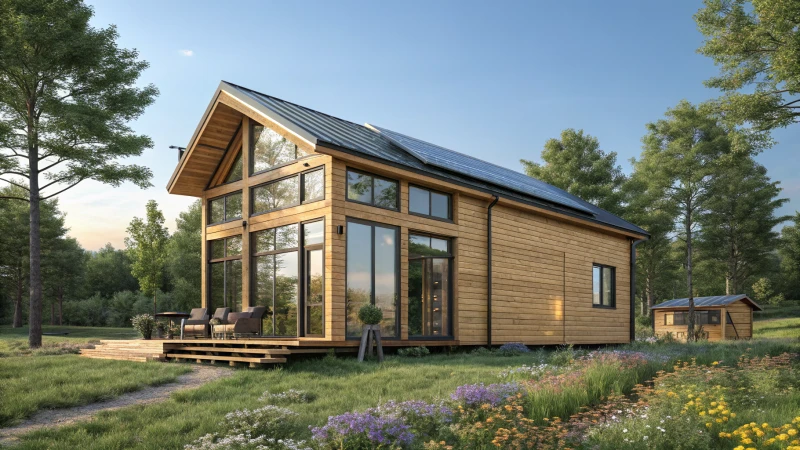
Insurance and Financing
When I first considered getting a tiny home, I was excited about the simplicity it promised. However, the reality of securing proper insurance7 quickly set in. It turns out, unlike a regular house, a tiny home doesn't always fit neatly into standard insurance categories. I had to dig deep to find a policy that covered everything without breaking the bank.
Financing was another hurdle. Many lenders look at tiny homes differently than they do traditional real estate. This meant facing higher interest rates or getting creative with financing options. It was a learning curve, but definitely something worth preparing for if you're considering this lifestyle.
Maintenance and Upkeep
Initially, the low cost of a tiny home was a huge draw for me. But soon, I realized that maintenance could sneak up with some hefty bills. Imagine finding out your cozy space needs a roof repair or has plumbing issues—that's a wake-up call! I learned to thoroughly vet the manufacturer and closely examine the materials used in construction to avoid these surprises.
| Potential Maintenance Costs | Estimated Cost Range |
|---|---|
| Roof Repairs | $500 - $2000 |
| Plumbing Fixes | $300 - $1500 |
| Pest Control | $100 - $500 |
Zoning and Regulatory Hurdles
Zoning laws were a whole new world for me. Depending on where you live, there can be strict regulations on where you can place your tiny home. It's crucial to understand building codes8 to avoid fines or worse—having to move your home altogether.
Customization Constraints
I imagined my tiny home just the way I wanted it—until I learned about the limited customization options with Amazon's models. If you're someone who craves personal touches or unique layouts, this can be a tough pill to swallow. Most homes are pre-designed kits with limited flexibility, which was quite a change from what I envisioned.
Long-term Viability and Resale Value
Lastly, thinking long-term is key. Unlike traditional homes, the resale value of a tiny home might not appreciate significantly. It's important to consider how this fits into your future plans and whether it's a sustainable choice for you.
In conclusion, while Amazon's tiny homes might seem like a great option initially, it's essential to do thorough research into these hidden costs and challenges to ensure they align with your personal and financial goals.
Tiny homes require specialized insurance coverage.True
Standard home insurance often doesn't cover tiny homes, needing special policies.
Zoning laws are lenient for placing tiny homes anywhere.False
Many areas have strict zoning laws that restrict tiny home placement.
Conclusion
Amazon's tiny homes offer affordable, eco-friendly living with easy assembly but may lack durability, customization options, and compliance with zoning laws, requiring careful consideration before investment.
-
Learn about the environmental benefits and sustainable features of Amazon's tiny homes. ↩
-
Check customer feedback on Amazon tiny homes for insights into quality and real-life experiences. ↩
-
Discover detailed price comparisons of Amazon's tiny homes to assess affordability and budgeting options. ↩
-
Exploring this link provides an overview of various assembly processes suitable for different industries. ↩
-
Clicking here reveals cutting-edge advancements that enhance assembly efficiency and precision. ↩
-
Learn how modular assembly can improve production times and adaptability. ↩
-
Understanding insurance requirements for tiny homes is crucial to avoid uncovered liabilities. ↩
-
Checking zoning laws ensures your tiny home is legally placed and compliant. ↩



